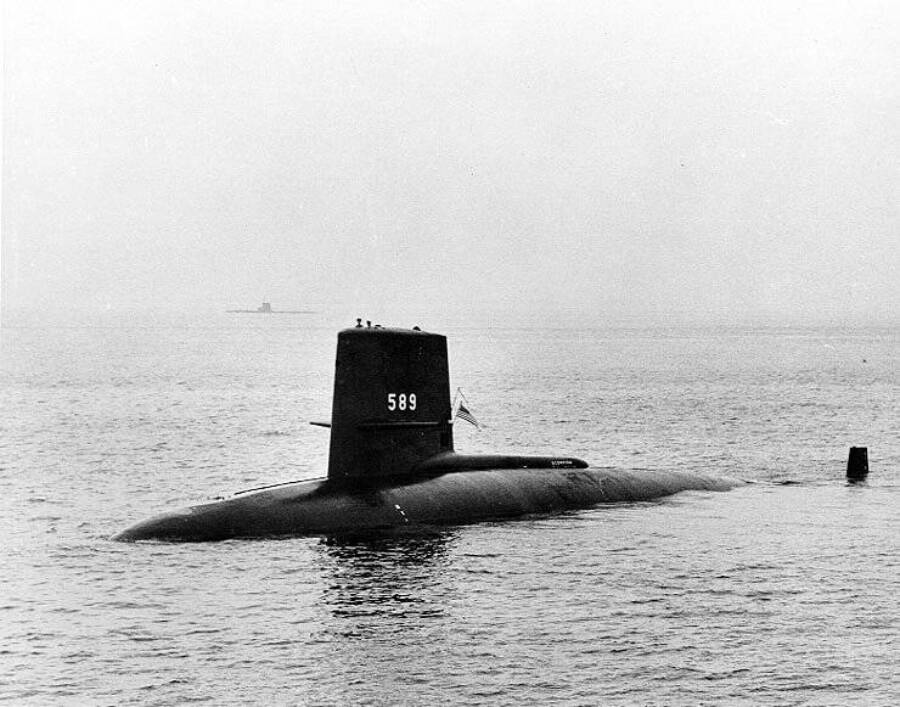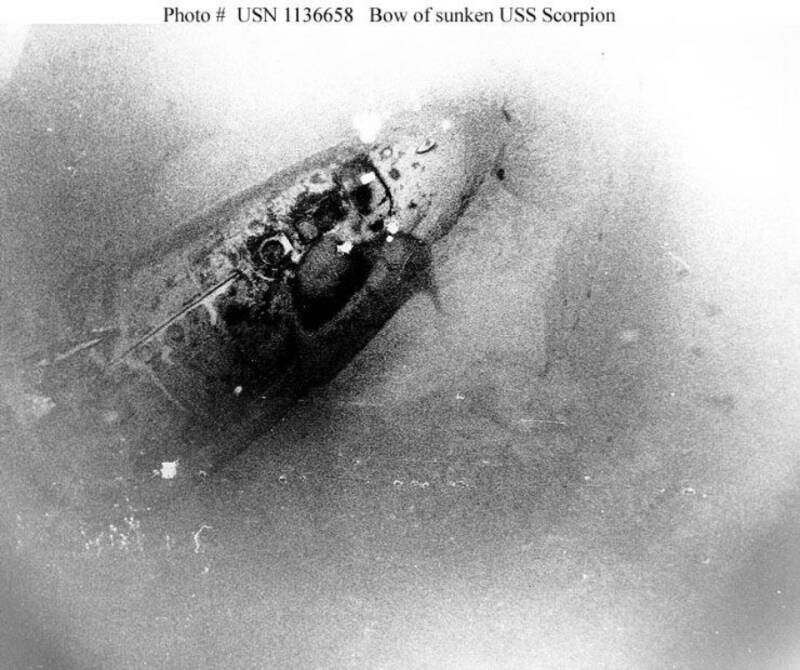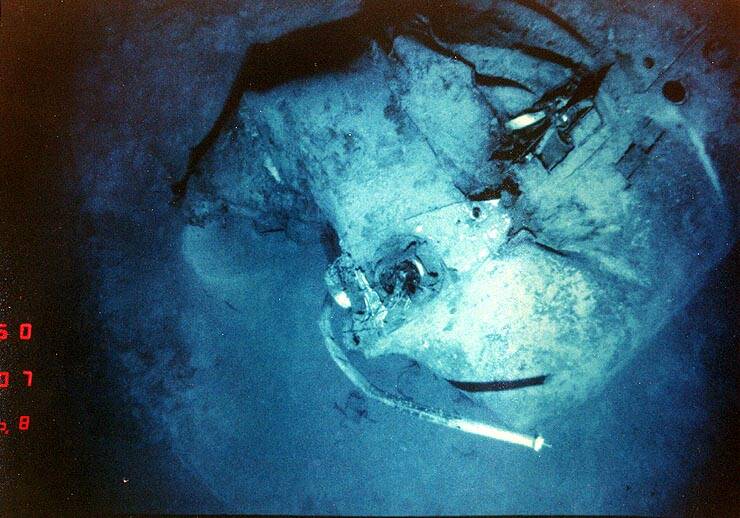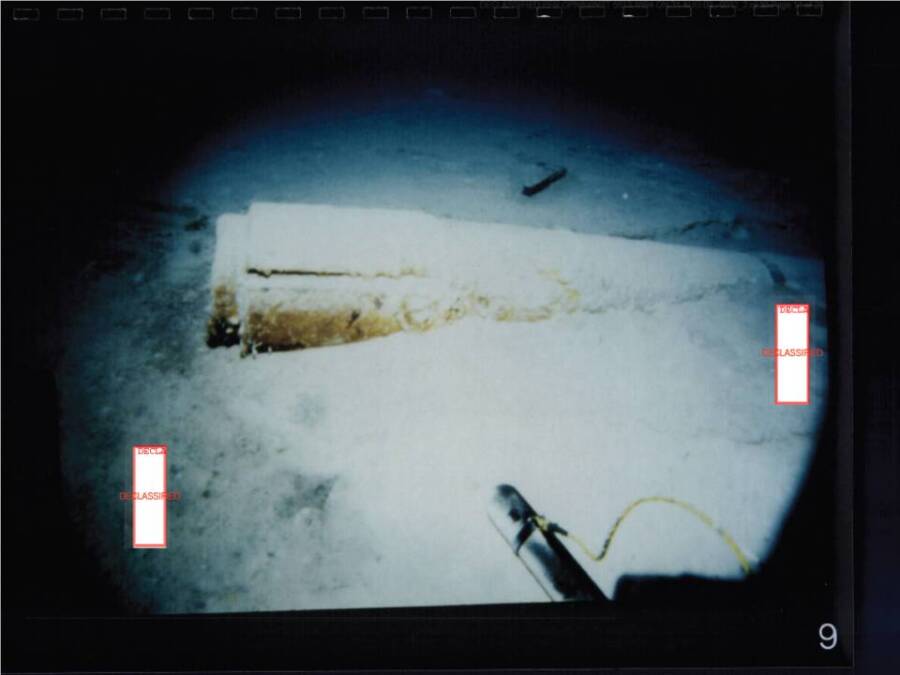The USS Scorpion vanished 400 miles southwest of the Azores on May 22, 1968. Then, the Navy kept key information from the missing crew's family members for years.

Wikimedia CommonsThe USS Scorpion was the last American submarine to go missing.
Since the end of World War II, the United States has only lost two nuclear submarines: the USS Thresher and the USS Scorpion.
The Thresher sank during deep-diving drills near Cape Cod, Massachusetts, in 1963, killing all 129 crew members on board. Afterward, the U.S. Navy implemented SUBSAFE, a rigorous submarine safety program to prevent future disasters.
Then, in 1968, the USS Scorpion, too, sank into the Atlantic Ocean — along with its nuclear power plant and the two nuclear weapons on board. This time, however, nobody could explain what caused the submarine to go down.
Still, over 50 years later, there is no definitive explanation for what happened to the USS Scorpion — but there are numerous theories.
A Nuclear Submarine Built For Speed
The USS Scorpion was laid down on August 20, 1958, by the Electric Boat Division of General Dynamics Corp. in Groton, Connecticut.
It was a Skipjack-class nuclear-powered attack submarine, part of a new generation designed to travel at incredible underwater speeds. Gone were the traditional diesel engines of submarines past — the Scorpion and its sister ships utilized nuclear power, allowing them to spend almost all of their time fully submerged.
The USS Scorpion (SSN-589) — the sixth of its name — was officially launched on Dec. 19, 1959. Per the Naval History and Heritage Command, the Scorpion was commissioned on July 29, 1960, where it set off from New London, Connecticut for a two-month deployment in European waters.

Wikimedia CommonsThe launch of the USS Scorpion in Groton, Connecticut.
After its early voyages, Norfolk, Virginia, is where the Scorpion would spend the majority of its career, used to help develop and refine undersea warfare tactics. The Scorpion was used in various exercises along the Atlantic coast and as far south as the waters of Bermuda and Puerto Rico. It was, after all, a top-of-the-line vessel.
As described by Popular Mechanics, the Scorpion was a 251-foot-long powerhouse. A single Westinghouse S5W nuclear reactor supplied 11,000 kilowatts of power to the submarine, allowing it to travel underwater at 33 knots (roughly 38 miles per hour).
The USS Scorpion was additionally equipped with 533-millimeter torpedo tubes and a mix of both anti-surface and anti-submarine weapons — and two nuclear torpedoes. Given the tension between the United States and the USSR at the height of the Cold War, the Scorpion was a valuable defensive and offensive vehicle to have at America’s disposal.
Unfortunately, the Scorpion would not remain at the United States’ disposal for long.
The Disappearance Of The USS Scorpion

Wikimedia Commons
After nearly seven years of service, the Scorpion was due for a full overhaul. So, in February 1967, repairs began at its base in Norfolk, Virginia. But the United States couldn’t afford to have one of its most efficient and effective submarines out of commission for long — especially not long enough to give it the total overhaul it required.
With Cold War tensions high, the decision was made only to conduct emergency repairs on the USS Scorpion.
The repairs were made, and by October 1967, the Scorpion was ready to hit the high seas once again — this time with a new commanding officer, Commander Francis Slattery. The Scorpion crew had also undergone refresher training, marking what seemed like a new beginning for the nuclear submarine.
So, on Feb. 15, 1968, the USS Scorpion set out to sea. With a crew of 99 on board, it set off for the Mediterranean.
The initial operation with the Sixth Fleet went according to plan, but as the Scorpion was set to return home on May 20, its crew was tasked with conducting a high-tech espionage mission. Its goal was to intercept a Soviet naval task force located southwest of the Canary Islands off the coast of Africa. The Soviets were thought to be conducting their own espionage mission, measuring acoustic signatures of NATO warships in the region.
The Scorpion was more than suited for the task — after all, it was essentially designed to go undetected. The crew checked in via radio on May 21, reporting that it was 250 miles southwest of the Azores and estimating it would return home from its mission on May 27.
Days came and went, with no news from the Scorpion.

Wikimedia CommonsA piece of the USS Scorpion wreck on the ocean floor.
Back at the Norfolk base, radio operators were growing concerned.
“I had never seen a captain or an admiral come into that place in the two and one-half years I worked there,” Ken Larbes, a Radioman Second Class at the time, told HistoryNet. “Now we had captains and admirals running around wanting more information. It was so crazy… They suspended all of the saluting and all that.”
Other radio operators reported arriving that morning and hearing chatter among the higher-ups that the Scorpion had gone missing. However, they didn’t realize that these conversations also dealt with how the U.S. Navy would cover up this disappearance.
The Navy Tries To Cover Up The Scorpion‘s Disappearance
Five days after the Scorpion disappeared, the Navy’s cover-up began. When the submarine failed to arrive at port on schedule, the Navy presented a straightforward explanation that omitted any mention of espionage against the Soviets.
Rather, they said that the Scorpion had been returning from a routine operation and then failed to arrive at port without explanation. The official account said that the incident began on the morning of May 27, when the Scorpion failed to surface at the Norfolk base.

Wikimedia CommonsThe shaft of the USS Scorpion on the ocean floor.
Family members of the Scorpion crew had gathered at the port, anxiously awaiting the arrival of their loved ones. Instead, they were greeted by heavy rains from a passing nor’easter — and no submarine. Some waited hours, growing increasingly worried, but most had gone home by the time night fell. It wasn’t until 6 p.m. that news stations first reported the Scorpion missing.
By the next morning, May 28, newspapers across the country were reporting on the story. The evening prior, Admiral Thomas H. Moorer, the Chief of Naval Operations, held an impromptu news conference at the Pentagon.
“The weather is very, very bad out there,” he told reporters. “But the weather may abate, the ship may well have been held back, and she could proceed into port.”
Moorer was telling the press a bald-faced lie. He knew the Scorpion had sunk days earlier, on May 22. For a week after the conference, Atlantic Fleet ships and patrol aircraft scoured the ocean for any signs of the USS Scorpion to no avail.
Then, in July 1968, the wreck of the USS Scorpion was discovered by the research ship USNS Mizar, which had captured photographs with a mounted camera of the wreck of the Scorpion lying on the ocean floor, two miles down.
A court of inquiry examined the photographs but ultimately reached the disappointing conclusion that the “certain cause of the loss of Scorpion cannot be ascertained from any evidence now available” on Jan. 31, 1969.
It would be years before anyone learned of the espionage mission that led the Scorpion to its demise.
What Really Happened To The USS Scorpion
In an interview 15 years after the disappearance of the Scorpion, Vice Admiral Arnold F. Schade provided his recollection of the event in a telephone interview — a recollection that shined a light on the whole affair and contradicted the official account the Navy had provided over a decade earlier.
Schade began by saying that the Scorpion had reported in as it was prepping to return home from the Mediterranean, saying it was in good shape and would not need to stop and reload. He also confirmed that the Navy had received news of a Soviet task force operating near the Canary Islands and that they had asked the Scorpion to examine it.
Then, Schade revealed the shocking truth that the Navy had been made aware of the disappearance of the Scorpion a full five days earlier than they previously claimed.
“They were due to report in to us shortly thereafter,” Schade said, referring to the period between May 19 and May 21 when the Scorpion was to be surveilling the Soviet fleet. “It was at that time we got a little suspicious, because they did not report, they did not check in, and then when we got to the time limit of their check-in, they were first reported as overdue.”
Schade went on to reveal that his command knew something was wrong within hours of the Scorpion sinking — not days later, on the 27th, after it failed to arrive at port.

Courtesy Family of Mark ChristiansenSeven members of the 99-man crew on board the USS Scorpion.
“All I know is that long before she was actually due in Norfolk, we had organized a search effort,” Schade said. “This went on for quite some time, until it was quite obvious that she was long overdue arriving in Norfolk.”
Then, decades later, in 2018, Larbes and fellow Radioman Mike Hannon dropped another bombshell: When senior officers crowded into the radio control room, they already knew that the Scorpion had been lost — and why.
“There were officers openly discussing the fact that they believed the Scorpion had been sunk,” Hannon said. The Navy’s top-secret Sound Surveillance System (SOSUS) had tracked the submarine’s sinking, as well as “the explosion.”
Hannon added that “a Soviet submarine was tracked leaving the area at a high rate of speed” just after the explosion.
Official reports in the years since the tragic sinking of the Scorpion have given little credence to the theory it was the result of a confrontation with the Russians.
In 1993, the Navy released a report pointing to flooding due to an unknown reason that could have led to a “cataclysmic event” or explosion. In 2012, the U.S. Submarine Veterans organization petitioned for another look into the disappearance of the Scorpion, but it was denied.
To this day, though there are a number of theories about the cause, no one truly knows what happened to the Scorpion and her crew — and it’s likely we never will.
After reading about the disappearance of the USS Scorpion, read about the sinking of the SS Andrea Doria and the tragic story behind it. Or, read the chilling story of the SS Ourang Medan, the ghost ship whose crew died with faces frozen in terror.





